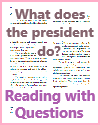Executive Branch Educational Materials |
| www.studenthandouts.com > Social Studies > Civics > Executive Branch of the U.S. Government |
 |
 |
|||||||||
| Executive Branch Workbook | What does the president do? Reading with Questions |
|
The executive branch is one of the three branches of the United States government, alongside the legislative branch (Congress) and the judicial branch (federal courts). The executive branch is responsible for implementing and enforcing laws, managing the day-to-day operations of the government, and conducting foreign relations. At the head of the executive branch is the President of the United States. Here are the key components and roles within the executive branch:
President of the United States: The President is the highest-ranking official in the executive branch and serves as the head of state and head of government. The President is responsible for executing and enforcing federal laws, making executive decisions, and setting policy agendas. The President also has significant powers in areas like foreign affairs, military command, and the appointment of federal officials. Vice President: The Vice President is the second-highest-ranking official in the executive branch and serves as the President's principal deputy. The Vice President is often tasked with specific roles and responsibilities, including presiding over the Senate and assuming the presidency in case of the President's inability to fulfill their duties. Cabinet: The President is assisted in managing various federal agencies and departments by the Cabinet, which consists of the heads of executive departments, such as the Secretary of State, Secretary of Defense, Secretary of the Treasury, and others. Cabinet members are appointed by the President and are responsible for overseeing specific policy areas. Executive Departments: There are 15 executive departments, each headed by a Cabinet secretary. These departments oversee specific areas of government policy, such as foreign affairs, defense, homeland security, health and human services, and more. They implement federal laws and regulations within their respective domains. Federal Agencies and Commissions: In addition to the executive departments, there are numerous federal agencies, bureaus, and commissions responsible for various functions, including regulation, law enforcement, research, and more. These agencies have specific areas of expertise and authority. Executive Orders: The President has the authority to issue executive orders, which are directives that have the force of law. Executive orders are often used to manage the executive branch, implement policy changes, or address immediate issues. Military Command: The President serves as the Commander-in-Chief of the United States Armed Forces, responsible for the overall command and control of the military. Foreign Policy: The executive branch plays a central role in conducting foreign relations, negotiating treaties (with the advice and consent of the Senate), and representing the United States on the world stage. Federal Bureaucracy: The executive branch oversees the federal bureaucracy, including civil servants and career officials who administer government programs and services. This bureaucracy is responsible for the day-to-day operations of the government. Law Enforcement: The executive branch includes various law enforcement agencies, such as the Federal Bureau of Investigation (FBI), the Drug Enforcement Administration (DEA), and the Bureau of Alcohol, Tobacco, Firearms and Explosives (ATF), among others. The executive branch operates under a system of checks and balances with the other branches of government. Congress can pass laws that the President must enforce, and the judiciary can review executive actions for constitutionality. This system helps ensure that no single branch becomes too powerful and that the government operates in accordance with the principles of the U.S. Constitution. |
| www.studenthandouts.com > Social Studies > Civics > Executive Branch of the U.S. Government |






